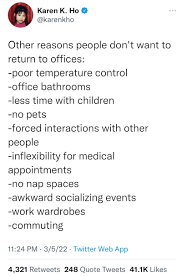No doubt about it – leading a team is not easy, especially when teammates are spread out with only the internet to connect them. Maintaining a remote workforce requires many things, including good business communication technology. More importantly, the human beings that make up the workforce also require attention and care.
When it comes to people’s needs and work styles, one size does not fit all. According to the Theory of Work Adjustment[1], work styles—as well as their environments—are characterized by their celerity, pace, rhythm, and endurance. When a person’s work style is compatible with their environment, they will have reached Person-Environment Fit, Demands-Ability Fit, and Needs-Supplies Fit, which increases productivity and job-retention.
Person-Environment Fit refers to a worker’s sense of belonging. This sense is personal, not technical. Do they like their manager and coworkers? In return, how well-liked are they?
The second criterion to Work Place Fit is Demands-Ability Fit. Does the job demand skills which the worker does not possess? Are there too many tasks and not enough time? On the other hand, if work is too easy, the job can become monotonous and unfulfilling. To protect against this, Browns and Brookes’ theory of Unfolding and Opportunity posits that a worker who has achieved Work Style Fit requires opportunities to expand their knowledge and skillsets in order to preserve Work Style Fit.[2]
Thirdly, Needs-Supplies Fit is exactly what it sounds like – does the employer provide the necessary supplies for the assigned tasks? In the office, this might look like keeping the copy machine in good condition. When working remotely, supplying employees’ needs is typically digital, such as webcams, team connectivity software, and high speed internet. Ever-importantly, supplying a worker’s needs also refers to fair and competitive pay.
The terms of Work Style Fit have been studied and implemented for the past several decades, typically in the context of hiring the right person. However, as 2020 revealed, nothing stays the same forever. A person, their abilities, and their needs change just as rapidly as a company’s environment, demands, and supplies. Open communication and flexibility between employee and employer are crucial for a productive remote workforce. While this is not always easy, it is pivotal to retaining a healthy, productive remote work environment that feels connected and valued.

A remote employee working from the beach
Here are five great tips on managing remote employees.
-
Sponsor each team member’s unique working style
A survey conducted on slack[3] pulled 9,000 workers across six different countries. The survey discovered that 72% prefer working either in hybrid or remote positions. Of that group, 13% prefer to work fully remote indefinitely. Many people appreciate the flexibility and freedom to accommodate their own unique working style, free from the peer-pressure and drama of sharing an office.
However, many executives and corporate leaders have pushed to return/remain in-office. The backlash against this idea has been swift and unrelenting. One twitter user said, “Y’all find it weird that suddenly every CEO in the world wants to do press about the ‘dangers’ of remote work and how less productive people really want to go back to the office? They lying. No one wants to go to the office. Ever.”[4] Another added a three-part list of “Reasons why people don’t want to return to offices” screenshotted below.[5]

Tweet from Mo_TheWriter

Tweet from Karenho

Tweet from Karenho

Tweet from Karenho 3
The decision to re
main remote means allowing – and encouraging – employees to work in a form that fits them best.
Some people thrive when left alone. These individuals are self-motivated, focused, and determined. They have the discipline to set deadlines and achieve them, and there is nothing they hate more than feeling “managed.” Independence is their greatest asset when maintaining Work Style Fit.
One way their leader can sponsor this style is to limit time-consuming meetings but always keep themselves available to chat. You can supply your remote teams with a link to your online calendar where they can schedule a meeting at their own convenience. This shows that your door is open without you breathing down their neck.
On the opposite side of the coin, some people are collaborative. They love teamwork, look forward to meetings which break up the day, and are often the first to send “Happy Birthday, Susan!” in the side chat. When in a physical office, this type of worker is most likely talking to the person next to them while still getting their tasks done. Working remotely might make them feel isolated, which leads to questions about their value and if they contribute enough compared to others. This is an example of declining Person-Environment Fit.
To compensate for this, you can provide ample positive feedback regarding their work and the personality they bring to the team. Software that allows them to connect with other team members, such as messaging, video calls, and conference calls, is also helpful. Not every communique needs to be work-related, but be sure to address any issues if this worker becomes a distraction to the rest of the team.
The third type of worker might describe their approach with the saying “there is a method to my madness!”. They prosper best in an office because there are other bodies around to keep them accountable. They thrive with strict deadlines to keep them on task.. Rest assured, they do their best work under pressure. People like these are prone to feel misunderstood due to their lack of conformity, so a little validation can go a long way with their feelings of belonging and Work Style Fit.
Explore working with them to figure out a way they can stay focused and goal-oriented. Perhaps they can do individual work while on a background call with the collaborative team member. Or maybe they would benefit from a company-sponsored co-work environment (a rented desk space within another office). Be open to trial and error. Remember that your team wants to succeed. Once given the right tools, what previously seemed like an “unfocused” worker can be a powerful asset to your company.
Flexibility can make all the difference when managing remote workers.
-
Be clear on team goals and individual goals
While keeping your management style personalized to each of your remote workers, also maintain unity and unbiased expectations. This will help achieve and maintain Demands-Ability Fit with all team members. Group emails and meetings keep remote team members on the same page.
A self-disciplined worker without many check-ins could possibly be running in the wrong direction with a new project. Rather than imposing several meetings which make them feel micro-managed, you can make sure they are clear from the start and reassure them that they can always come to you with questions. This way, an occasional email or call can act as affirmation rather than task-managing.
Be aware: if you have regular meetings with some of the more collaborative remote employees, you might accidentally find your vision evolving. Habitually review your original statement of goals and evaluate: is this change better or worse? If it is better, make sure to inform the rest of the team. Keep in mind, changing instructions after someone has already made progress can be frustrating, invalidating, and isolating. Proceed wisely. It does not hurt to ask how severely this change would undermine your team’s progress before instituting the change.

Remote Employee Manager working on laptop.
-
Unfolding and Opportunity
A great team leader also empowers their team to grow in their abilities as the demands arise. The development of simple skills into larger, more complex skills is called “unfolding”. In order for this unfolding to take place, opportunity must be presented. However, if this opportunity is presented without Work Style Fit, the employee is likely to feel undervalued and taken advantage. On the other hand, when the Work Style Fit is thriving, an opportunity to grow one’s skills is exhilarating, challenging, and fulfilling.
While leading your team towards Unfolding and Opportunity, often take time to check-in with each member. During a time of change and/or expansion, it is easy to lose sight of the people you lead. Being mindful and proactive to preserve someone’s Person-Environment Fit, Demands-Ability Fit, and Needs-Supplies Fit will go a long way in keeping your team excited and engaged with the projects ahead. All change, even good change, requires evaluation, adaptation, and compromise.
-
Invite feedback from remote workers
People are sure to feel unvalued if they feel unheard. In private meetings or calls, it is good practice to ask if there is anything you or the company can do for them. You do not have to agree with what they say, but be sure to resist your instinct to defend yourself or the company. Let your team member see you record their complaint. Promise to look into it (and make good on your promise!). In your next meeting, you can bring it back up – which shows that you care – and give them an update.
Some might be uncomfortable providing feedback directly to you, which is when anonymous surveys come in handy. They don’t have to be long. In fact, sending out shorter surveys more often helps workers feel heard without taking too much of their time. You don’t want to over-burden them with long forms that can take valuable time away from their productivity.
With every performance review dished out, welcome one returned. If an employee is reviewed on exemplifying company values, ask them if the company lives out its own values. If an employee is asked to self-evaluate something they think they should do better, supply them with some self-reflection of yourself. Candor can help protect against perceived hypocrisy. It shows you do not think of yourself or the company as “above the law”.
It is also good to keep up with public discourse about a remote workforce. Reading credible news sources such as Forbes or The Times can offer insight into problems that you and your company are already facing, but to get ahead of the game, check Twitter and TikTok. There is no shortage of voices, opinions, and testimonials under hashtags like #remoteworker or #microsoftteams. These voices are from the perspective of the employees, not the business owners or journals published by the wealthy. Here, you will learn about emerging problems before the other bosses do, and you can address them before the problem grows beyond repair.
A recent example of the benefits of social media knowledge is “Quiet Quitting.” A quick Google search of the term will reveal articles about companies losing their remote workers concerned with work life balance and trying to figure out ways to end this trend. However, a studious employer who has been using TikTok would have known six months earlier that #workplaceboundaries and similar hashtags were already trending. Popular videos and Tweets taught users how to politely enforce boundaries within the verbiage of their contracts. Employers were left scratching their heads, wondering why their subordinates suddenly became unwilling to go “above and beyond,” but social media users were not surprised.
https://www.tiktok.com/t/ZTRbEacpD/
https://www.tiktok.com/t/ZTRbEuEgF/
https://www.tiktok.com/t/ZTRbEhDoA/
A team manager who saw these videos of employees enforcing boundaries would be well-informed of potential dissatisfaction surfacing within their own team. If you bring up popular topics and ask for feedback, your remote employees will feel fostered, respected, and appreciated. Refer to point number three for ways you could invite this honest feedback.
-
Don’t let the tech be the problem
Can’t be connected without a good connection!
Jacob Morgan, a four times best-selling author, TED and keynote speaker, and creator of the Future of Work University said[6], “Managers understand that they exist to support employees, not vice versa. Flatter structures require a “central nervous system”, allowing employees to access anything from anywhere at any time.”[7]
How does a manager create a centralized nervous system that supports all of their employees, even remote workers?
The foundational needs are obvious – a computer, some wifi, and, the business communications services that encourage connection. The most basic communication necessities include business voice services, messaging, and video conferencing.
Does each team member have the ability to speak with each other and connect face-to-face? Can they message their coworkers quickly, beyond email, like having the ability to text each other using company phone numbers?
If you’d like to explore the possibilities of what managing remote employees with an advanced business communications stack could look like, consider setting up an exploratory meeting with a representative from smpl here.

smpl – The Power of Connection
Switching between several apps to access different services slows a person’s learning curve, and they can easily become frustrated. This mistake also increases the likelihood that messages will fall through the cracks, thus breaking down the team’s communication functionality. Keep it simple by focusing on only those services which matter most.
Effective business apps can accommodate written, voice, and video communications and will make all the difference in how painlessly your team learns to connect.
If your employees spend a lot of their time on calls, they are sure to appreciate being provided hardware that makes their jobs easier. If you are going to invest in telephone hardware, look for models that include access to advanced call routing tools, receptionist tools, and more. This will save your team the time it takes to complete these tasks manually.
If a portion of your team works in an office while others work remotely, it is wise to buy office communication supplies from the same brand or manufacturer as your remote workers. This ensures compatibility and makes it easy for employees to switch between getting work done in-person and/or off-site.
Even better, select tech that is compatible with screens and wallboards that your team members are likely to already have, such as an Amazon FireTV.
Modern technology tools make successful remote workforce management far more attainable than in the past. Plan for growth and invest in products and services that can keep up with your business’ expanding reach. By entering a long-term relationship with a company that provides these services, you will ensure continued access to new and improved hardware and software. Rather than trying to keep up on your own, a group that specializes in digital communication can help you adjust to the ever-changing needs of your business, industry, and team.
In Conclusion
A great manager rises to the challenge of meeting their remote teams individual and evolving needs. Connecting with a team member on their level and working together to achieve the business’ goal will help them to feel seen and appreciated. By working down the list of theory of Work Adjustment, you can ensure your remote workers are productive, valued, and connected within your company.
[1] Bayl-Smith, Piers H., and Barbara Griffin. 2018. “Maintenance of D-A Fit through Work Adjustment Behaviors: The Moderating Effect of Work Style Fit.” Journal of Vocational Behavior 106 (June): 209–19.
[2] D. Brown, L. Brooks (Eds.), Career choice and development (3rd ed.), Jossey-Bass Inc., San Francisco (1996), pp. 75-120
[3] “Statistics on Remote Workers that will Surprise You.” Apollo Technical: Engineered Talent Solutions. 2 December 2022. https://www.apollotechnical.com/statistics-on-remote-workers/#:~:text=A%20survey%20by%20slack%20of,home%20if%20given%20the%20choice
[4] @Mo_TheWriter. Twitter Post. 15 May 2021.
[5] @KarenKHo. Twitter Post. 5-6 March 2022.
[6] Morgan, Jacob. LinkedIn. Date of Access: 7 January 2023.
[7] Babajide, Ronke. “Micromanagers Are Trying to Make Us Go Back to the Office. And the gossips and slackers are cheering them on.” Medium. 14 May 2021. https://medium.com/predict/micromanagers-are-trying-to-make-us-go-back-to-the-office-c831b897ca70








 Built in California, Enjoyed Worldwide
Built in California, Enjoyed Worldwide
Recent Comments